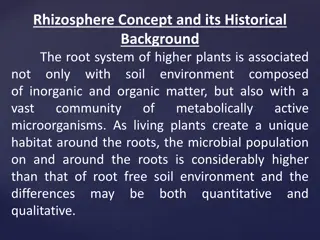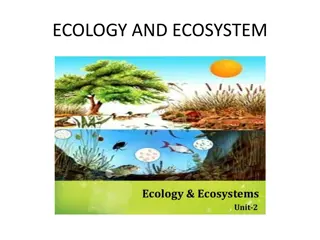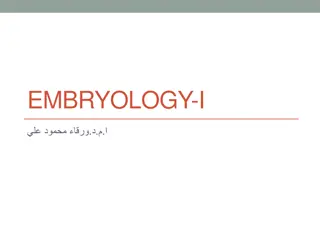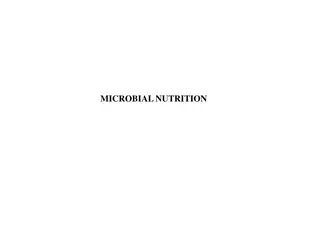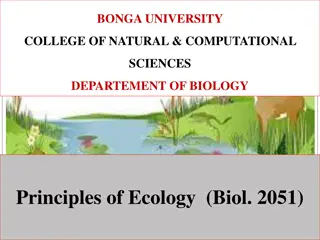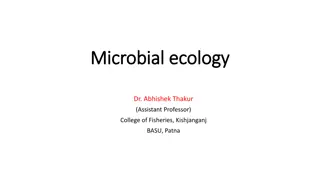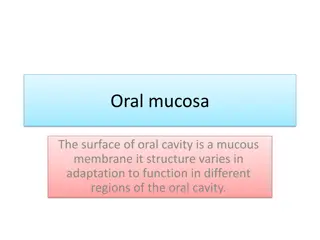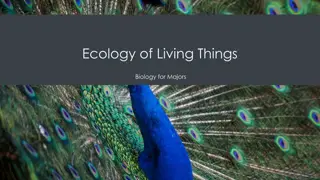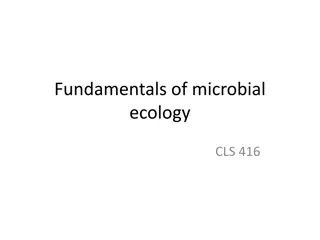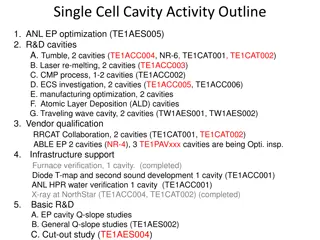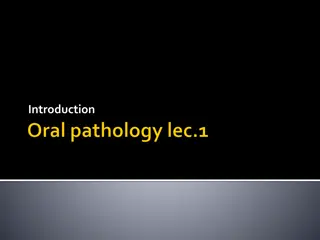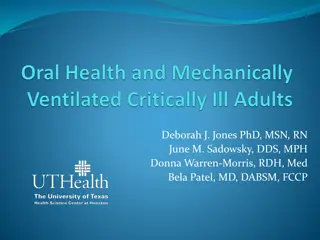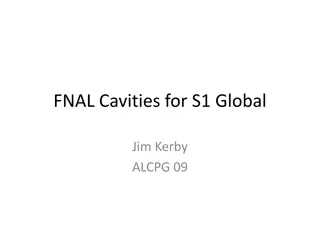Understanding Microbial Ecology in the Oral Cavity
The oral cavity is a unique ecological system that plays host to a diverse resident microflora, consisting of various bacterial species, yeasts, and other microorganisms. This dynamic microbial community interacts with the human body, contributing to its normal development and defense systems. The composition of the oral microflora changes over time and is influenced by factors such as tooth surfaces, saliva, and pH levels. Acquisition of the resident oral microflora begins at birth and evolves in diversity during the initial months of life, with pioneer species like streptococci paving the way for the emergence of Gram-negative anaerobes. Understanding the microbiology of caries sheds light on the complexities of bacterial growth in planktonic and biofilm forms within the oral cavity.
Download Presentation

Please find below an Image/Link to download the presentation.
The content on the website is provided AS IS for your information and personal use only. It may not be sold, licensed, or shared on other websites without obtaining consent from the author. Download presentation by click this link. If you encounter any issues during the download, it is possible that the publisher has removed the file from their server.
E N D
Presentation Transcript
Microbiology of caries Dr. Rihab Abdul Hussein Ali B.D.S , M.Sc. , PhD.
Oral cavity is a unique ecological system, which is warm, moist and relatively opens to the outer environment. Tooth surfaces as well as dental plaque constantly encounter different challenges from food intake, speech, and so on. Bacteria grow in two different ways: planktonic and biofilm forms. Because biofilm is composed of various species of organisms, interactions with other members of the multispecies community in the oral cavity can influence the behavior of dental bacterial plaque.
Microbial ecology in the oral cavity It has been estimated that the human body is made up of over 1 1014 cells, of which 90 % are the microorganisms that comprise the resident microflora of the host. The resident microflora dynamicallyinteracts with the human body, contributing directly and indirectly to the normal development of the physiology, nutrition, and defense systems of the host.
The composition of the resident microflora is distinct in different habitats/ niches such as the oral cavity. The resident microflora has a diverse composition, consisting of a wide range of Gram- positive and Gram-negative bacterial species, as well as yeasts and other types of microorganism. In addition, the composition of the oral microflora will change as the biology of the mouth alters over time, the oral cavity, for example, the tooth surfaces provide distinct binding factors for microorganisms. Moreover, the mouth is continuously bathed with saliva at a temperature of 35 36 C and a pH of 6.75 7.25.
Acquisition of the resident oral microflora The mouth of the newborn baby is usually sterile. Acquisition depends on the successive transmission of microbes to the site of potential colonization. In the mouth, although organisms can be derived from water, food and other nutritious fluids, the main route of transmission is via saliva. Molecular typing studies have shown that the acquisition of oral streptococci and Gram- negative species in children is predominantly from their mother (vertical transmission).
The diversity of the oral microflora increases during the first months of life. The earliest colonizers of a site are termed pioneer species, and these are streptococci, particularly S. salivarius, S. mitis and S. oralis. With time, Gram-negative anaerobes appear, including Prevotella melaninogenica, Fusobacterium nucleatum and Veillonella spp.
The eruption of the dentition creates novel habitats for microbial colonization because teeth provide the only non-shedding surfaces within the body to which the resident microflora can normally attach. This results in the undisturbed accumulation of large communities of bacteria, especially at stagnant sites. Microbial deposits on teeth are an example of a microbial biofilm.
Mutans streptococci and S. sanguinis generally only appear in the normal mouth following tooth development and maturation of dental biofilms create conditions suitable for a greater range of more fastidious bacteria. In addition, the flow of gingival crevicular fluid (GCF) around the gingival margin provides a source of essential nutrients for many obligate anaerobes. eruption, and the
The oral microflora continues to increase in diversity until, eventually, a stable situation is reached, termed the climax community. The microbial populations that comprise such a climax community remain stable over time, despite regular minor disturbance to the local environment due to changes in diet, hormonal levels, oral hygiene, etc. The stability is termed microbial homeostasis ; this is not a passive response by the organisms, but reflects a highly dynamic equilibrium between the resident microflora and the conditions at that site in the host. local environmental
A major change to the habitat, such as frequent sugar consumption, can lead to imbalances among the species comprising the resident microflora, a consequence of which can be an increased predisposition to disease. Changes in the microflora can, however, occur as a direct or an indirect effect of aging. Direct effects, such as the waning of cell- mediated immunity, can lead to increases in the carriage of non-oral bacteria (e.g. staphylococci and enterobacteria).
Indirect effects include the increased wearing of dentures among the elderly, which promotes colonization by yeasts. Older people are also more likely to be on long-term medication, a common side- effect of which is a reduced salivary flow rate promoting colonization by lactobacilli and yeasts.
Site distribution of oral bacteria Although the mouth is highly selective for the microorganisms that are able to colonize and become established, more than 700 different types have been detected in the mouth. The mouth is not a homogeneous environment for microbial colonization. Distinct micro- habitats exist such as mucosal surfaces (palate, cheek, tongue, etc.), the various surfaces of teeth (smooth, proximal, fissures) and the gingival crevice.
For example, the tongue has a highly papillated surface providing protection in the crypts to fastidious bacteria including obligate anaerobes. Indeed, the tongue can act as a reservoir for many species that are commonly found in dental plaque.
Ecological factors affecting the growth and metabolism of oral bacteria The mouth provides both a friendly and a hostile environment for microbial growth. Resident oral microorganisms are adapted to use endogenous (host-derived) nutrients for growth (e.g. salivary proteins and glycoproteins), but superimposed on this can be sudden and irregular intakes of dietary carbohydrates in excess (e.g. readily fermentable sugars such as glucose, fructose and sucrose).
The mouth is overtly aerobic, and obligate anaerobes and facultative anaerobic bacteria are able to persist within biofilms on oral surfaces (tongue, teeth) Organisms have to attach firmly to a surface to avoid being washed away by the flow of saliva and swallowed.
Saliva plays other roles in regulating the growth and metabolic activity of the oral microflora. It contains glycoproteins and proteins that act as the primary source of carbohydrates, peptides and amino acids for microbial growth. Bacteria cooperate to degrade the oligosaccharide side-chains of glycoproteins such as mucins. Acid is produced relatively slowly from the metabolism of these compounds. Saliva delivers a spectrum of innate and specific immune host defense factors which are essential to the maintenance of a healthy mouth.
Dental biofilms: development, structure, composition and properties The term biofilm has been used to signify the common features among biofilms forming on teeth and biofilms forming in other environments. Biofilm is defined as aggregates of bacterial cells attached to a surface and embedded in a polymeric matrix that is self-produced and helps the community to gain tolerance against antimicrobials and host defenses.
Development of dental biofilms The development of dental biofilms can be divided into several stages: 1- Pellicle formation 2- Attachment of single bacterial cells (0 24 h) is a reversible attachment. 3- Growth of attached bacteria by specific molecules on their cells interact with the complementary receptor proteins on the pellicle surface leading to the formation of distinct micro- colonies (4 24 h).
4- Microbial succession (and co-adhesion) leading to increased species diversity concomitant with continued growth of micro-colonies (1 7 days) 5- Climax community/mature biofilm (1 week or older) including synthesis of extra polysaccharides.
Pellicle formation - The teeth are always covered by an acellular proteinaceous film; this is the pellicle that forms on the naked tooth surface within minutes to hours before microbial colonization. - The major constituents of the pellicle are salivary glycoproteins, phosphoproteins, lipids and, to a lesser extent, components from the GCF. - In uncolonized areas the pellicle reaches a thickness of 0.01 1 m within 24 h. - Remnants of cell walls from dead bacteria, and other microbial products (e.g. glucosyltransferases and glucans), have also been identified in the pellicle.
- Some salivary molecules undergo conformational changes when they bind to the tooth surface; this can lead to exposure of new receptors for bacterial attachment. - The pellicle plays an important modifying role in caries and erosion because of its permeable-selective nature restricting transport of ions in and out of the dental hard tissues.
- The presence of a pellicle inhibits subsurface demineralization of enamel in vitro. - The composition of the pellicle may aid in determining the composition of the initial microflora. It has been speculated that the surface characteristics of different dental hard tissues and dental materials may influence the profile of amino acids in the pellicle and thereby modify the number of potential adsorption sites for different bacterial species.
Microbial colonization Microbial colonization of teeth requires that bacteria adhere to the surface. As the microbial cell approaches the pellicle-coated surface, long- range but relatively weak physicochemical forces between the two surfaces are generated. Initially, bacteria are non-specifically associated with the tooth surface under the net influence of van der Waal s attractive forces as well as repulsive electro- static forces.
Within a short time, these weak physicochemical interactions may become stronger owing to adhesins on the microbial cell surface becoming involved in specific, short-range interactions with complementary receptors in the acquired pellicle.
Initial microbial colonization Cocci are probably the first to adhere because they are small and round. The first or primary colonizers tend to be aerobic (oxygen-tolerant) bacteria including Neisseria and Rothia. The streptococci, the Gram-positive facultative rods, and the actinomycetesare the main organisms in both early fissure and approximal plaque.
As plaque oxygen levels fall, the proportions of Gram-negative rods, for example fusobacteria, and Gram-negative cocci such as Veillonella tend to increase and they are predominating in the subgingival plaque during the later phases of plaque development. Irrespective of the type of tooth surface (enamel or root), the initial colonizers constitute a highly selected part of the oral microflora, mainly S. sanguinis, S. oralis and S. mitis. Together, these three-streptococcal species account for 95% of the streptococci and 56% of the total initial microflora.
Microbial succession The initial establishment of a streptococcal flora appears to be a necessary forward for the subsequent proliferation of other organisms. Such population shifts are known as microbial succession. As the microbiota ages the most striking change is a shift from a Streptococcus-dominated plaque to a plaque dominated by Actinomyces. The principle of microbial succession is, briefly, that pioneer bacteria create an environment that is either more attractive to secondary invaders or increasingly unfavorable to themselves because of a lack of nutrients, accumulation of inhibitory metabolic products, and/or increase in anaerobiosis, etc.
In this way, the resident microbial community is gradually replaced by other species more suited to the modified habitat. The secondary colonizers also attach to the established pioneer species via adhesin receptor interactions (termed coaggregation or coadhesion). As dental biofilms develop, some of the bacteria produce polysaccharides, especially from the metabolism of sucrose, and these contribute to the biofilm matrix. the matrix is biologically active and is involved in retaining nutrients, water and key enzymes within the biofilm.
As the composition of the developing biofilm becomes more diverse, the bacteria can interact both in a conventionalbiochemical manner and via specific signaling molecules. As the bacterial deposits become thicker, a lowering of the oxygen concentration (increased anaerobiosis) is one of the factors that help to drive microbial succession. Thus, in developing coronal plaque, a progressive shift is observed from mainly aerobic and facultatively anaerobic species in the early stages to a situation in which facultatively and obligately anaerobic organisms predominate after 9 days.
Microbial composition of the climax community (mature biofilm) The composition of dental plaque is diverse, and includes a range of Gram-positive and Gram- negative bacteria, most of which are facultatively or obligately anaerobic. Of relevance to dental caries is the presence in dental biofilms of high numbers of acid-producing Gram-positive cocci, such as the mutans streptococci, other streptococci (non-mutans streptococci) and Gram-positive rods (lactobacilli and some Actinomyces spp.).
However, the acidogenic potential of these bacteria can be reduced by other organisms in plaque, such as the anaerobic Gram-negative coccus, Veillonella spp., which converts lactic acid to weaker acids as part of a food chain, or by bacteria generating alkali from arginine (S. sanguinis) or urea (S. salivarius, A. naeslundii). This demonstrates the complexity of the challenge when attempting to find correlations between the microbial composition of dental plaque and the development of caries.
Dental plaque matrix Itconsists of different species of bacteria that are notuniformly distributed because different species colonize the tooth surface at different times and under different circumstances. The newly formed supragingival biofilm frequently exhibits palisades (columnar microcolonies of cells) made up of firmly attached cocci, rods, or filaments.
Dental calculus A last stage in the maturation of some dental plaques is characterized by the appearance of mineralization in the deeper portions of the plaque to form dental calculus. Calculus formation is related to the fact that saliva is saturated with respect to calcium and phosphate ions. Supragingival calculus forming on the tooth coronal to the gingival margin frequently develops opposite the duct orifices of the major salivary glands. Subgingival calculus forms from calcium phosphate and organic materials derived from blood serum, which contribute to mineralization of subgingival plaque.
Alkaline conditions in dental plaque may be an important predisposing factor for calculus formation. Bacterial phospholipids and other cell wall constituents may act as initiators of mineralization, in which case it may begin in the cell wall and subsequently extend to the rest of the cell and into the surrounding matrix. Calculus is generally covered by actively metabolizing bacteria, which can cause caries, gingivitis, and periodontitis.
From studies, there is specific type of bacteria to develop dental caries following the type of tooth surfaces: Smooth surfaces : S. mutans, S. salivaris, Actinomyces. Occlusal fissures : S. mutans, S. sanguinis, lactobacilli, Actinomyces spp. Approximal surfaces: Actinomyces spp., Gram negative bacteria., Fewer streptococci. Cervical surfaces: Actinomyces spp., Anaerobic bacteria.



